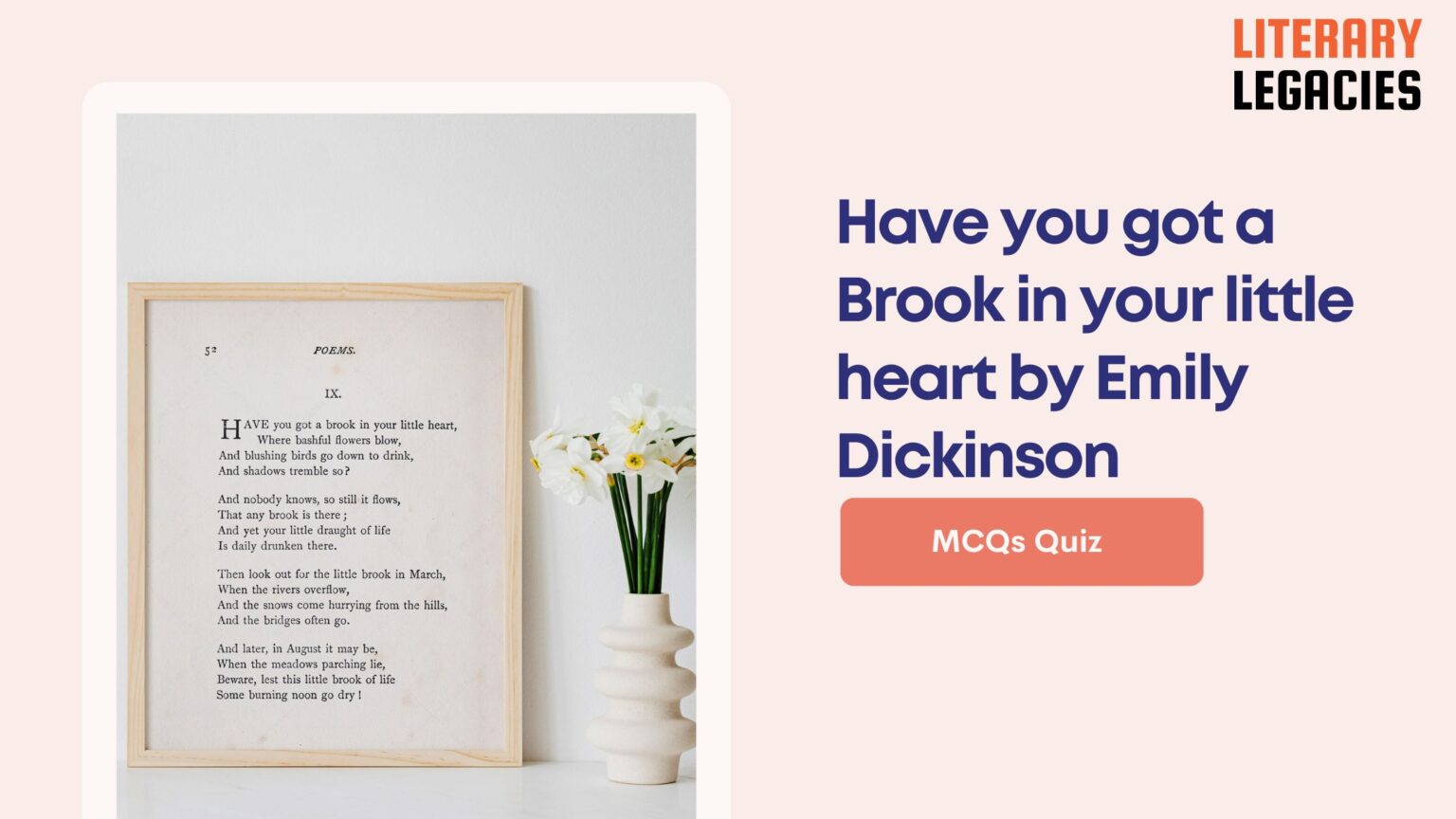1. What is the poem being compared to in the third stanza?
A. An ocean
B. A lake
C. A brook
D. A river
Answer: A brook (C)
The poem builds upon the metaphor of a ‘Brook’ being a place of joy for our heart.
2. What does the poem suggest we should value?
A. Only the smallest and most insignificant things
B. Even the smallest things that mean something to us
C. Everything, regardless of its significance
D. Only the biggest and most significant things
Answer: Even the smallest things that mean something to us (B)
Emily emphasizes the importance of valuing small things that hold meaning to us.
3. What is the significance of the month ‘August’ in the poem?
A. It means ‘to ripen’ and bring to ‘fruition’
B. It is a month of celebration
C. It is a hot summer month
D. It is a month of sadness
Answer: It means ‘to ripen’ and bring to ‘fruition’ (A)
The word ‘August’ also means ‘to ripen’ and bring to ‘fruition’, adding depth to the poem’s meaning.
4. What is the ‘little brook’ in the poem a metaphor for?
A. A person’s heart
B. The writer’s pen
C. A work of art
D. A place of joy
Answer: A work of art (C)
The ‘little brook’ is a metaphor for a work of art, specifically the poem itself.
5. What is the danger of having too much energy when creating art?
A. The artwork will be incomplete
B. The artwork will be perfect
C. The artwork will be unreadable
D. The artwork will be destroyed
Answer: The artwork will be unreadable (C)
If there is too much energy, the poem will overflow and become unreadable.
6. What happens if we neglect our art and let the ink dry?
A. Nothing will flow from our pen
B. Our art will flourish
C. Our art will remain the same
D. Our art will be perfect
Answer: Nothing will flow from our pen (A)
If we neglect our art, nothing will flow from our pen and we will be unable to express what is in our heart.
7. What is the importance of maintaining our ‘little brook’?
A. Because it will make us famous
B. Because it is a waste of time
C. Because they are delicate and require great care
D. Because it brings us joy
Answer: Because they are delicate and require great care (C)
The importance of maintaining our ‘little brook’ lies in the fact that they are delicate and require great care.
8. What is the poem suggesting the writer is doing when creating a work of art?
A. Building it up quickly
B. Building it up with an overabundance of energy
C. Building it up one line at a time
D. Not building it at all
Answer: Building it up one line at a time (C)
The poem suggests that the writer is building it up one line at a time, like each line were a little brook.
9. What can happen to the poem if there is an overabundance of energy?
A. It will overflow and become unreadable
B. It will remain the same
C. It will become a masterpiece
D. It will be destroyed
Answer: It will overflow and become unreadable (A)
If there is an overabundance of energy, the poem will overflow and become unreadable.
10. What is the poem ultimately about?
A. The beauty of nature
B. The act of creation
C. The importance of poetry
D. The power of words
Answer: The act of creation (B)
One reading of this poem is that it is writing about writing, and the act of creation.
11. What is the main idea being discussed in Emily’s poem?
A. The beauty and power of nature in our lives
B. The importance of physical exercise for well-being
C. The impact of social media on our mental health
D. The fragility and care required for one’s inner strength and hope
Answer: The fragility and care required for one’s inner strength and hope (D)
The poem focuses on the delicate nature of one’s inner source of strength and hope.
12. What does the word ‘brook’ mean as a verb according to the OED?
A. To dry up
B. To flow rapidly
C. To skip or jump
D. To enjoy the use of, make use of, profit by
Answer: To enjoy the use of, make use of, profit by (D)
According to the OED, ‘brook’ as a verb means to enjoy the use of, make use of, profit by.
13. What is the overall image created by Emily’s description of the ‘brook’?
A. Fast-moving and energetic
B. Dry and lifeless
C. Delicate, easily frightened, and requiring care
D. Powerful and fierce
Answer: Delicate, easily frightened, and requiring care (C)
The adjectives ‘bashful’, ‘blushing’, and ‘tremble’ create an image of the ‘brook’ as delicate and easily frightened.
14. What does Emily relate the verb ‘brook’ to?
A. The liver, both physically and morally
B. The brain, both physically and intellectually
C. The lungs, both physically and emotionally
D. The heart, both physically and spiritually
Answer: The heart, both physically and spiritually (D)
Emily relates the verb ‘brook’ to the heart, both physically and spiritually.
15. Why does Emily describe the ‘brook’ as a secret place?
A. Because it is a mythical place
B. Because it is a place that each person has, but it is unknown to others
C. Because it is a public place
D. Because it is a place known only to herself
Answer: Because it is a place that each person has, but it is unknown to others (B)
Emily describes the ‘brook’ as a secret place because it is a place that each person has, but it is unknown to others.
16. What is the meaning of the word ‘still’ in the second stanza?
A. Moving rapidly
B. Being completely silent
C. Making a loud noise
D. Not moving, or at least not moving fast enough to notice
Answer: Not moving, or at least not moving fast enough to notice (D)
The word ‘still’ in the second stanza means not moving, or at least not moving fast enough to notice.
17. What is the author of the article suggesting when comparing Emily’s poem to ‘Water, is taught by thirst’?
A. That both poems are about water
B. That both poems are written in the same style
C. That both poems are about the importance of physical exercise
D. That both poems explore the idea of a secret that everyone knows ‘nobody knows’
Answer: That both poems explore the idea of a secret that everyone knows ‘nobody knows’ (D)
The author suggests that both poems explore the idea of a secret that everyone knows ‘nobody knows’.
18. What is the ‘garden’ referred to in the article?
A. A public park
B. A metaphorical place of inner strength and hope
C. A physical garden
D. A botanical garden
Answer: A metaphorical place of inner strength and hope (B)
The ‘garden’ referred to in the article is a metaphorical place of inner strength and hope.
19. What is the tone of the poem?
A. Delicate and tender
B. Confident and assertive
C. Sarcastic and ironic
D. Angry and aggressive
Answer: Delicate and tender (A)
The tone of the poem is delicate and tender, as seen in the adjectives used to describe the ‘brook’.
20. What is the purpose of Emily’s poem?
A. To describe a physical landscape
B. To tell a story about a person’s life
C. To convince readers of a particular argument
D. To explore the idea of inner strength and hope
Answer: To explore the idea of inner strength and hope (D)
The purpose of Emily’s poem is to explore the idea of inner strength and hope.
21. What is the central idea of the theme ‘Emotional Resonance’ in the poem?
A. The subtle and often unnoticeable nature of emotions within an individual’s heart
B. The need to express emotions through artistic creation
C. The importance of external validation for emotional well-being
D. The power of emotions to influence external circumstances
Answer: The subtle and often unnoticeable nature of emotions within an individual’s heart (A)
The poem explores the emotions and experiences that reside within an individual’s heart, emphasizing their subtle and often unnoticeable nature.
22. What literary device is used to convey the hidden and changing nature of emotions in the poem?
A. Alliteration
B. Onomatopoeia
C. Personification
D. Imagery
Answer: Imagery (D)
The poem employs vivid imagery of ‘bashful flowers,’ ‘blushing birds,’ and the changing seasons to convey the hidden and changing nature of emotions.
23. What is the attitude conveyed in the closing lines of the poem?
A. Celebration of emotional turmoil
B. Encouragement to take risks
C. Indifference to emotional experiences
D. Caution to be attentive to one’s emotional health and well-being
Answer: Caution to be attentive to one’s emotional health and well-being (D)
The closing lines convey a cautionary attitude, encouraging readers to be attentive to their emotional health and well-being.
24. What is the significance of the ‘brook’ in the poem?
A. It represents the external environment
B. It symbolizes the varying states of inner emotions and experiences
C. It is a metaphor for creativity
D. It is a literal body of water
Answer: It symbolizes the varying states of inner emotions and experiences (B)
The central metaphor of a brook serves as an extended metaphor for the emotions and inner experiences within an individual’s heart.
25. What is the tone of the poem’s opening lines?
A. Curious and contemplative
B. Excitable and energetic
C. Critical and judgmental
D. Detached and uninterested
Answer: Curious and contemplative (A)
The poem opens with a curious and contemplative tone, inviting readers to consider the presence of emotions within their hearts.
26. What is emphasized in the theme ‘Emotional Well-Being’?
A. The importance of external validation
B. The need to express emotions through artistic creation
C. The neglect of emotional health leading to emotional depletion
D. The power of emotions to influence external circumstances
Answer: The neglect of emotional health leading to emotional depletion (C)
The poem underscores the importance of nurturing and tending to one’s emotional well-being, as neglect can lead to emotional depletion.
27. What is the significance of the seasons in the poem?
A. They symbolize the changing nature of emotions and experiences
B. They are used to describe the physical environment
C. They are a metaphor for creativity
D. They represent different stages of life
Answer: They symbolize the changing nature of emotions and experiences (A)
The poem’s shift between different seasons symbolizes the varying states of inner emotions and experiences.



